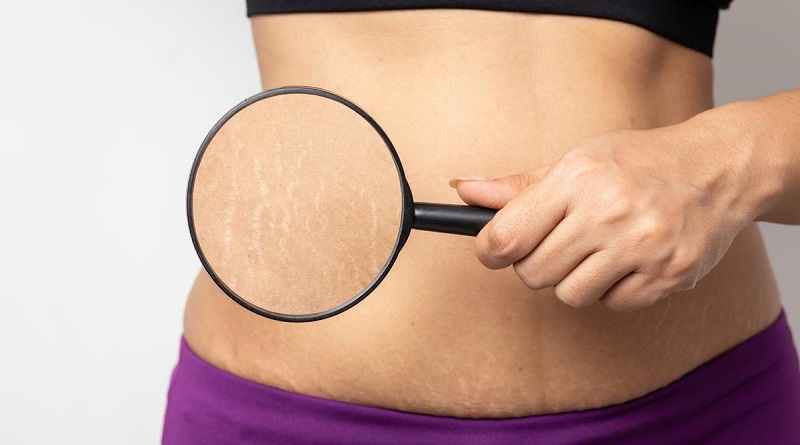Stretch marks are a common aesthetic problem for many people, especially women. These unsightly wrinkles on the skin are a source of discomfort and affect self-esteem. While these don’t cause health problems, not harmful to your health they can indicate underlying medical conditions or lifestyle choices. They appear as visible lines or streaks on the skin and are often a result of rapid weight gain, growth spurts, or pregnancy.
In this article, we will discuss the causes of stretch marks, including genetic factors, pregnancy, rapid weight gain or loss, and medical conditions.
What are Stretch Marks?
Stretch marks, also known as striae, are thin, linear scars that occur on the skin when it rapidly extends beyond its normal capacity. They come in a variety of hues, including purple, red, white, and silver. These are most frequent on the belly, thighs, hips, buttocks, and breasts, although they may develop anywhere on the body.
See Also: How to get rid of Acne Scar
Causes of Stretch Marks
Pregnancy
Pregnancy is one of the most common causes of stretch marks in women. As the baby grows, the skin on the abdomen stretches to accommodate the growing fetus. This can lead to the development of stretch marks, particularly during the third trimester. Hormonal changes during pregnancy can also affect the elasticity of the skin, making it more susceptible to tears.
See Also: Physical Changes to Expect in Your Body During Pregnancy
Medical Conditions
Certain medical conditions can also cause stretch marks. These include Cushing’s syndrome, Marfan syndrome, and Ehlers-Danlos syndrome. Cushing’s syndrome is a condition that occurs when the body produces too much cortisol, a hormone that can affect the skin’s elasticity. Marfan syndrome and Ehlers-Danlos syndrome are genetic disorders that can affect the body’s connective tissues, including the skin.
Puberty
During puberty, young people experience a sudden increase and rapid weight gain or weight loss. This sudden stretching and contraction can lead to streaks on the hips, thighs, and breasts.
See also: How to Reduce the Breast Size
Hormonal Change
Hormonal changes in the body can also contribute to the development of streaks. For example, pregnancy hormones can weaken the skin’s elasticity and make it more susceptible to stretching and tearing.
Weight Gain / Loss
When you gain weight quickly, your skin is forced to stretch beyond its natural capacity, which can cause the collagen and elastin fibers in the skin to tear. This tearing results in the appearance of stretch marks. This is common during pregnancy or periods of weight gain or loss.
See Also: How Prune Juice is effective for weight loss
Corticosteroids
Corticosteroid creams, pills, and lotions used to treat certain skin conditions can also cause it by lowering the collagen level in your skin. It reduces the skin’s ability to stretch and can develop. Prolonged use of corticosteroid medications, such as prednisone, can weaken the skin’s elasticity and lead to the development of streaks.
Genetics Factors
Some individuals are more prone to developing streaks due to their genetic makeup. If a person’s parents or grandparents have stretch marks, they are more likely to develop them as well. This is because genetics can influence the elasticity of the skin and how well it can cope with rapid expansion or growth.
Body Building
Bodybuilders often have stretch marks. It appears due to a rapid increase in muscle mass and sometimes abuse of anabolic steroids to accelerate muscle growth.
See Also: Exercises to lose weight
How to Identify the Causes of Stretch Marks
These are common skin concern that affects many people. These unsightly lines on the skin can appear anywhere on the body and can be caused by various factors such as weight gain, pregnancy, and genetics. But did you know that certain health conditions can also contribute to the development of streaks? In this article, we’ll explore how healthcare professionals identify the causes of stretch marks and what tests they may recommend.
Identifying through Visual Examination
A dermatologist or other healthcare professional can usually identify stretch marks by conducting a visual examination of your skin. They will look for thin, reddish, or purplish lines on your skin that may appear in a zigzag pattern. These lines may eventually fade to a lighter color or become shiny, silvery-white lines. If you have concerns about your striae, it’s essential to consult with a healthcare professional who can help diagnose the underlying cause.
Reviewing Medical History
Your healthcare provider will also review your medical history to determine if any underlying health conditions are contributing to your streaks. Some health conditions that can cause stretch marks to include:
Cushing’s Syndrome
Cushing’s syndrome is a condition that occurs when the body produces too much cortisol, a hormone that regulates stress. High levels of cortisol can weaken the skin’s elastic fibers, leading to development.
Marfan Syndrome
Marfan syndrome is a genetic disorder that affects the connective tissue in the body, including the skin. People with Marfan syndrome often develop stretch marks on their shoulders, hips, and lower back.
Ehlers-Danlos Syndrome
Ehlers-Danlos syndrome is another genetic disorder that affects connective tissue. People with this condition may develop stretch marks on their hips, lower back, and thighs.
Chronic Liver Disease
Chronic liver disease can cause hormonal imbalances in the body, leading to the development of stretch marks.
Anorexia Nervosa
Anorexia nervosa is an eating disorder that can cause significant weight loss, which can lead to the development of stretch marks.
Other health conditions such as anetoderma and pseudoxanthoma elasticum can cause lesions on the skin that resemble stretch marks.
Diagnostic Tests
If your healthcare provider suspects that an underlying health condition is causing your stretch marks, they may recommend diagnostic tests to identify the root cause. These tests may include blood or urine tests to evaluate hormonal imbalances or imaging tests such as ultrasound or CT scans to assess the health of your internal organs.
Prevention and Treatment
While it may not be possible to completely prevent the development of stretch marks, there are several steps you can take to minimize their appearance:
- Maintain a healthy weight through a balanced diet and regular exercise.
- Stay hydrated by drinking plenty of water.
- Avoid rapid weight gain or loss.
- Use moisturizers and creams that contain vitamin E or hyaluronic acid to keep the skin supple and hydrated.
- Avoid prolonged use of corticosteroids or other medications that can weaken the skin’s elasticity.
If you already have stretch marks, there are several treatments available that can help reduce their appearance, including:
- Topical creams or oils that contain retinoids, hyaluronic acid, or alpha hydroxy acids.
- Laser therapy, can stimulate the production of collagen and improve the appearance of stretch marks.
- Microneedling involves creating tiny punctures in the skin to stimulate collagen production and improve the appearance of stretch marks.
Read About: Home Remedies To Get Rid Of Stretch Marks
Conclusion:
These are common skin conditions that can be caused by a variety of factors, including rapid weight gain, genetics, hormonal changes, growth spurts, medical conditions, and corticosteroid use. While it may not be possible to completely prevent the development of streaks, there are several steps you can take to minimize their appearance.
Read More:




